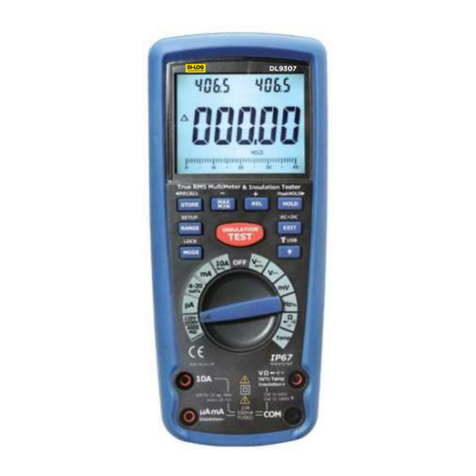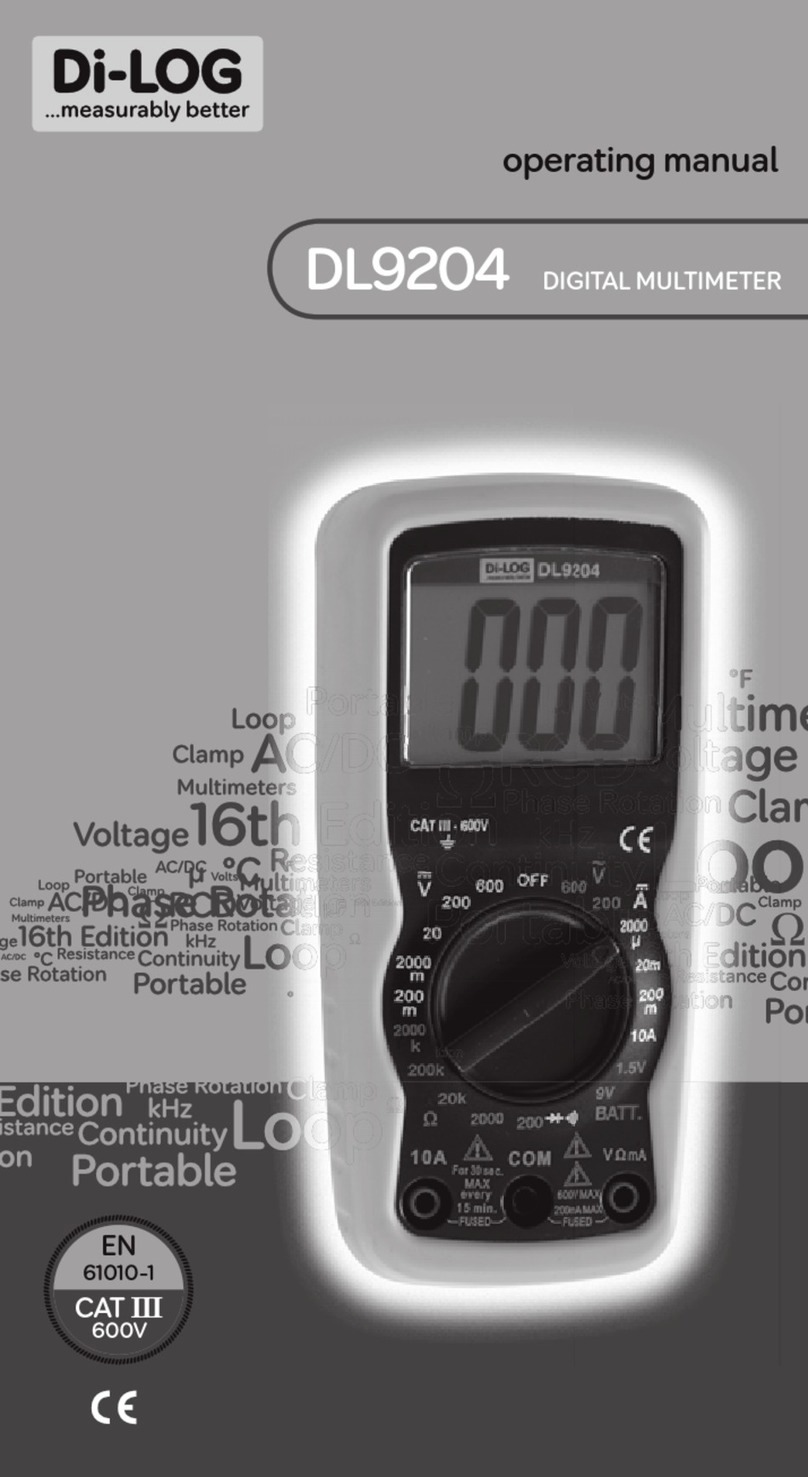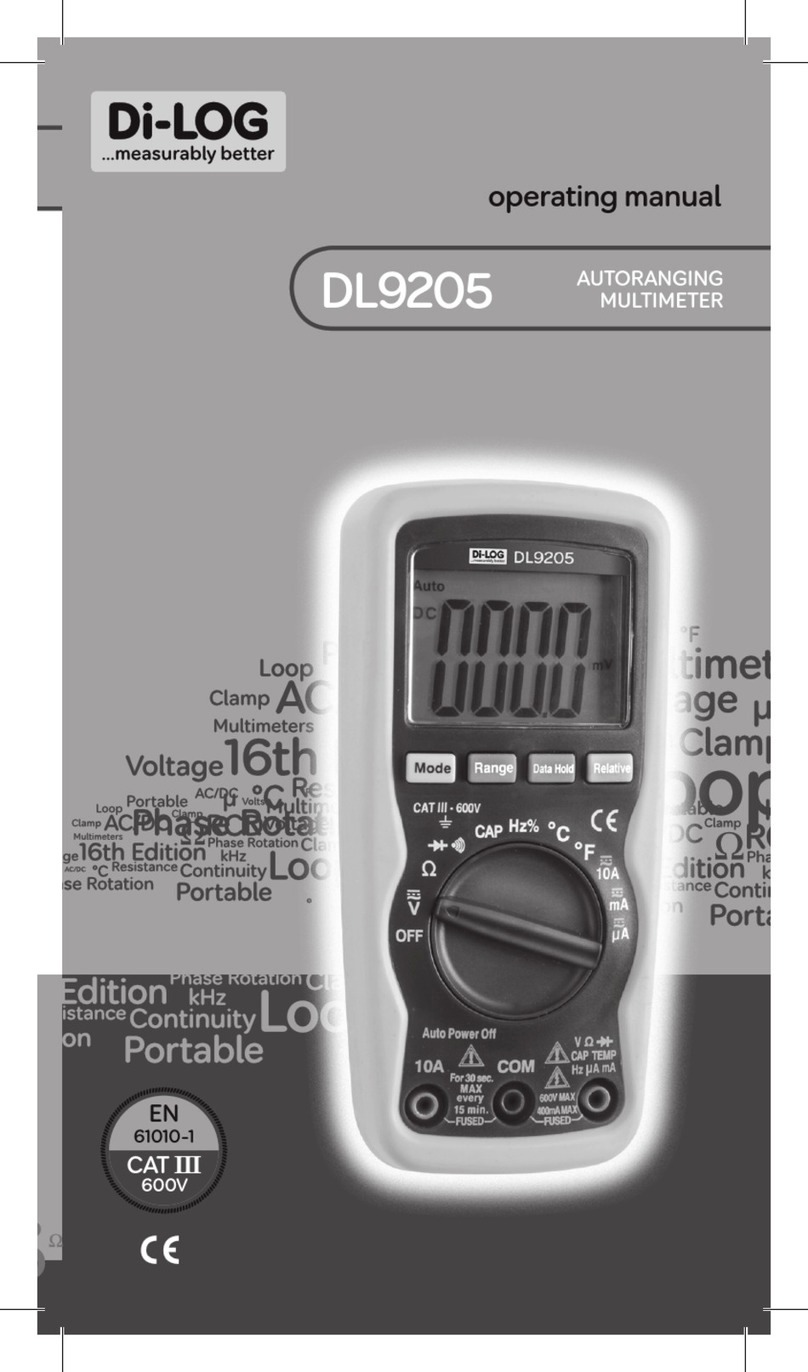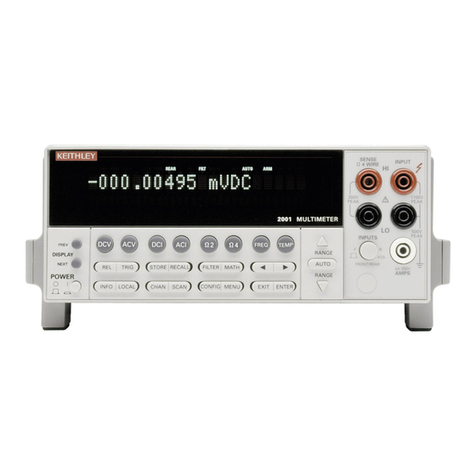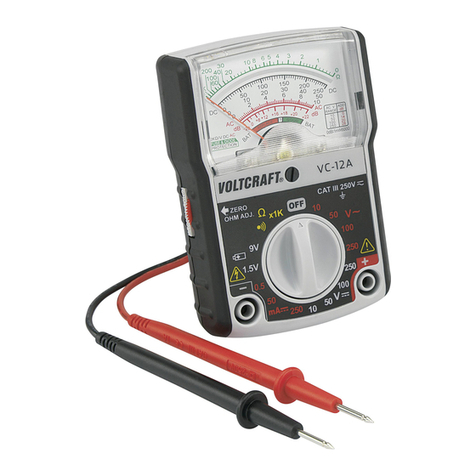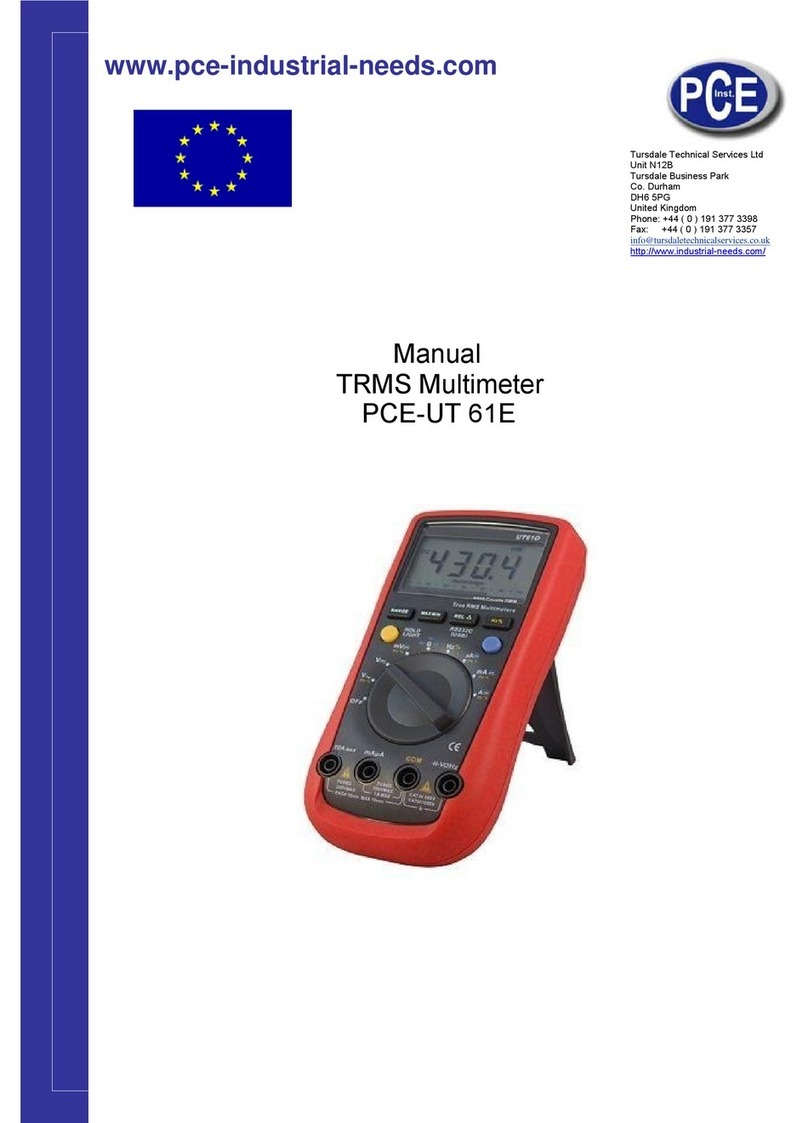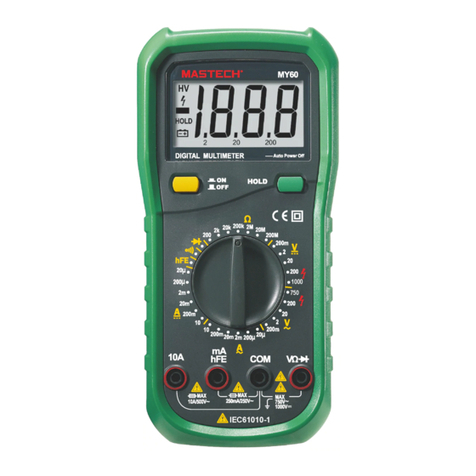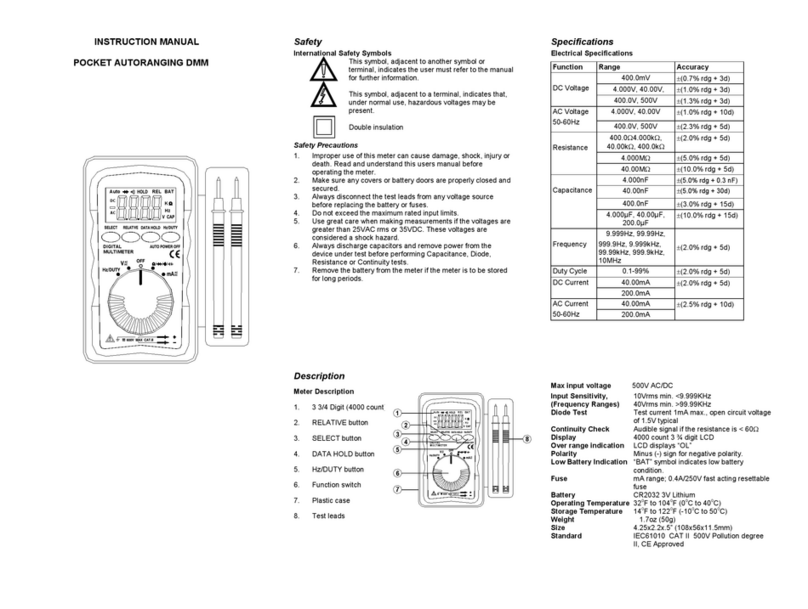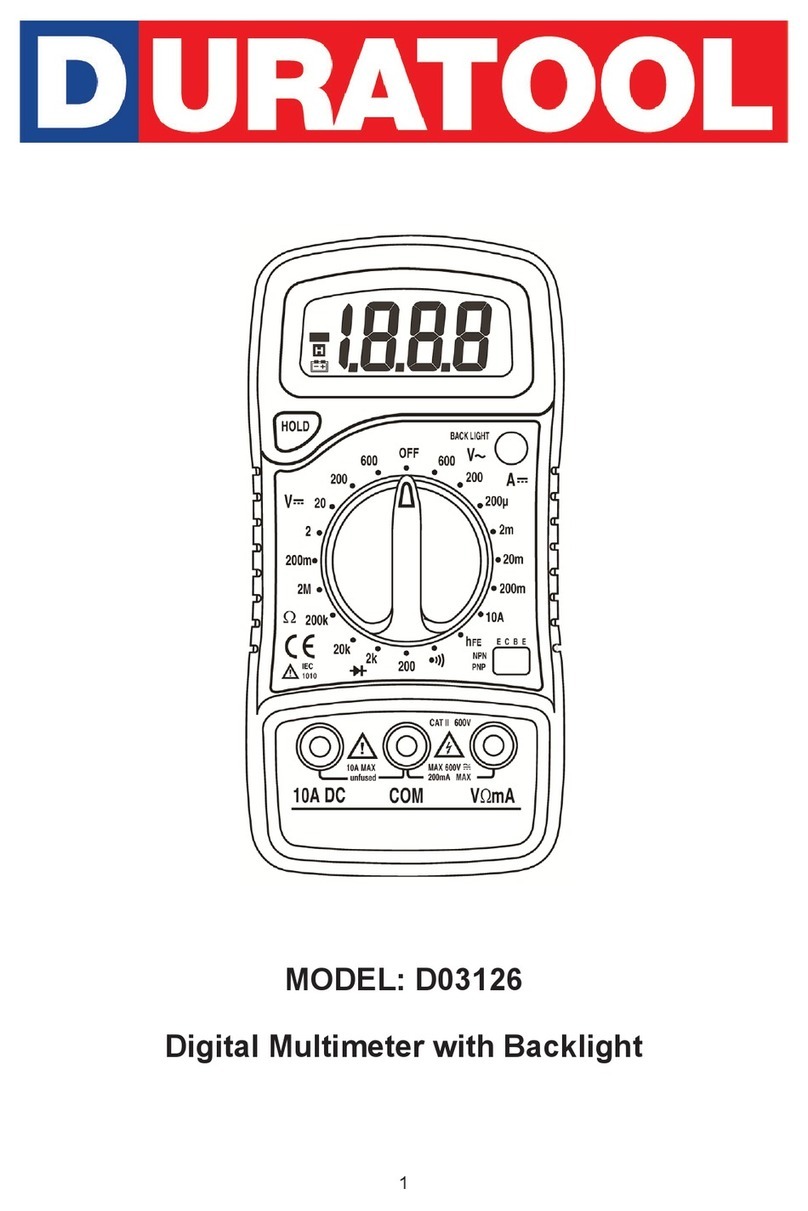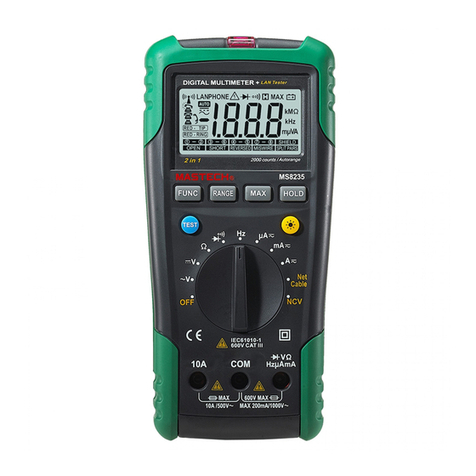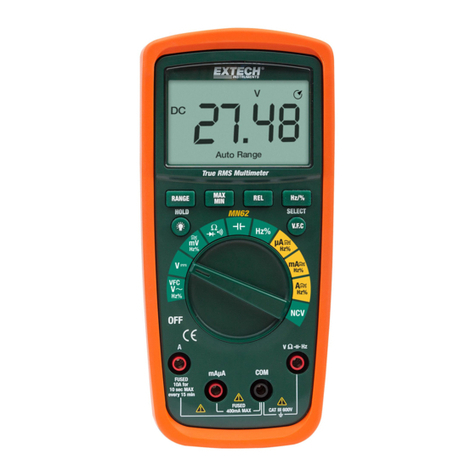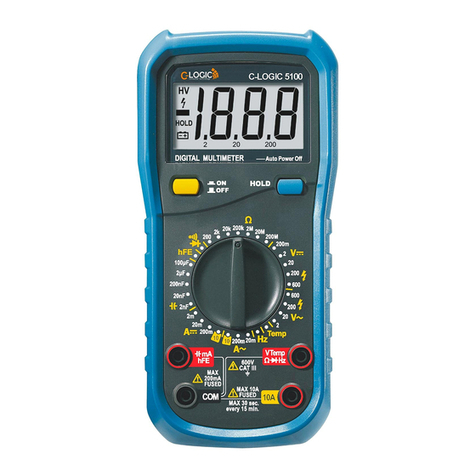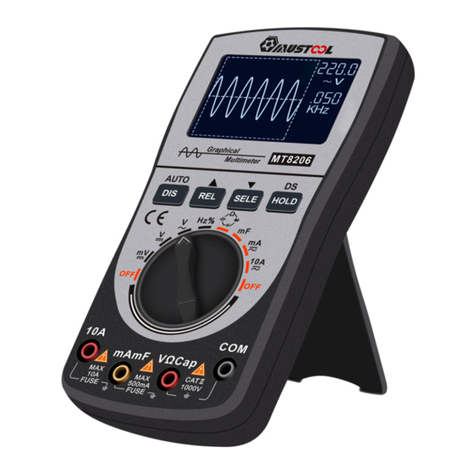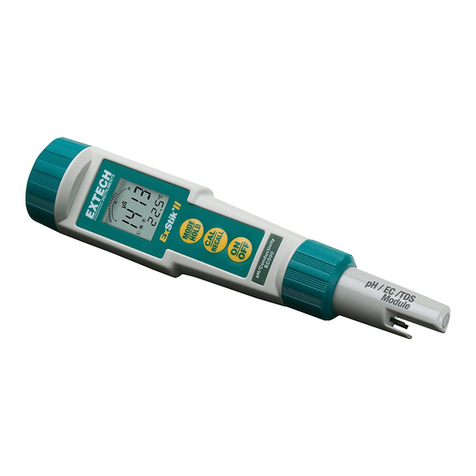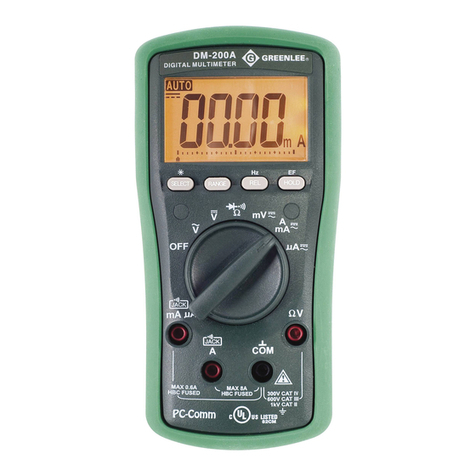Dilog DL9308 User manual

Warranty & Maintenance
TRUE RMS AUTORANGING
DIGITAL MULTIMETER
operating manual
Di-Log Test Equipment
28 Wheel Forge Way,
Trafford Park,
Manchester
M17 1EH, UK
tel: + 44 161 87 7 0322 fax: + 44 161 877 1614
email: sales@dilog.co.uk website: www.dilog.co.uk
EN
61010-1
CAT III
1000V
DL9308/9

Safety Information
This manual contains information that must be
followed for operating the meter safely and
maintaining the meter in a safe operating condition.
If this meter is not used in the manner specied, the
protection provided may be impaired.
Warning! Warns of potential danger, refer to the
instruction manual to avoid personal injury or
damage to the meter.
Caution! Dangerous voltage. Danger of electrical
shock.
Continuous double or reinforced insulation
complies with IEC536, class II.
Symbol of conformity, conrms conformity with
relevant EU directives. The meter complies with
EMC directives (89/336/EEC). Specically stand-
ards EN 50081-1 and EN 50082-1 as well as the
Low Voltage Directive (73/23/EEC) described in
the standard EN 61010-1.

Safety Information Safety Information
The meter has been designed in accordance with
the safety regulations for electronic measuring
instruments, EN 61010-1, IEC 61010.
Voltages above 75V DC or 50V AC may constitute a
serious shock hazard.
Before using the meter check for physical damage to
the casing in particular around the connectors. If the
case is damaged do not use the meter.
Check the test leads for damaged insulation or
exposed metal. Check the leads for continuity.
Replace damaged leads with identical model or
specication before using the meter.
Where applicable use GS38 approved leads (not
supplied) these are available from Di-Log. When using
test leads keep ngers behind the nger guards.
Do not apply more than the rated voltage, as marked
on the meter between the terminals or between any
terminal and ground.

Safety Information
Before making a measurement ensure that the rotary
switch is set to the appropriate range. Do not turn the
rotary switch whilst making a measurement.
Use the appropriate terminals, function and range for
your measurements. If the value to be measured is
not known use the maximum measurement position
and reduce the range step by step until a satisfactory
reading is obtained.
Do not use or store the meter in an environment of
high temperature, humidity, fumes, vapour, gaseous,
inammable and strong magnetic eld. The perform-
ance and safety of the use may be compromised in
such circumstances.
Disconnect circuit power and discharge all high
voltage capacitors before testing resistance,
continuity, diodes, capacitance or current.
Before measuring current check the meters fuses and
turn off power to the circuit before connecting the
meter to the circuit.

Safety Information Safety Information
Replace the battery as soon as the low battery
indicator appears. If the battery is low the meter
may give false readings.
Turn the meter power off when not in use,. Remove
the battery if the meter is in use for a long period.
Constantly check the battery as it may have leaked.
A leaking battery will damage the meter.
The meter may only be opened by a qualied service
technician for calibration and repair.

Input Limits
Never apply voltage or current to the meter that exceeds
the specied maximum:
Function Maximum
V DC or V AC 1000VDC/AC rms
mA DC/AC 500mA 1000V fast acting fuse
A DC/AC 10A 1000V fast acting fuse (20A for
30 seconds max every 15 minutes)
Frequency, Resistance, 1000VDC/AC rms
Capacitance,
Diode test, Continuity
Temperature 1000VDC/AC rms
Surge Protection: 8kV peak per IEC 61010
1. Use extreme caution when working with high
voltages.
2. Do not measure voltage if the voltage on the
“COM” input jack exceeds 600V above earth
ground.
3.
Never connect the meter leads across a voltage
source while the function switch is in the current,
resistance, or diode mode. Doing so can damage
the meter.
4.
Always discharge lter capacitors in power sup-
plies and disconnect the power when making
resistance or diode tests.

Input Limits
5. Always turn off the power and disconnect the
test leads before opening the covers to replace
the fuse or batteries.
6.
Never operate the meter unless the back cover
and the battery and fuse covers are in place and
fastened securely.
7. If the equipment is used in a manner not
specied, the protection provided by the
equipment may be impaired.
Input Limits

Controls and Inputs
1. 6,000 count LCD display
2. RANGE button
3. Hz and % button
4. Mode button
5. Function switch
6. mA, µA and 10A input terminal
7. COM input terminal
8. Positive input terminal
9. HOLD and Backlight button
10. RELATIVE button
11. MAX/MIN button
Note:
Tilt stand and battery compartment are on rear of unit.
1
8
3
2
4
5
6
7
9
10
11

Controls and Inputs Controls and Inputs
Auto power off
•))) Continuity
Diode test
Battery status
n nano (10-9) (capacitance)
µ micro (10-6) (amps, cap)
m milli (10-3) (volts, amps)
A Amps
k kilo (103) (ohms)
F Farads (capacitance)
M mega (106) (ohms)
Ω Ohms
Hz Hertz (frequency)
% Percent (duty ratio)
AC Alternating current
DC Direct current
ºF Degrees Fahrenheit
MAX Maximum
V Volts
REL Relative
AUTO Autoranging
HOLD Display hold
ºC Degrees Centigrade
MIN Minimum

Operations
Warning:
RISK OF ELECTROCUTION. HIGH-VOLTAGE CIRCUITS,
BOTH AC AND DC, ARE VERY DANGEROUS AND
SHOULD BE MEASURED WITH GREAT CARE.
1. Always turn the function switch to the
OFF position when the meter is not in use.
2. If “OL” appears in the display during a
measurement, the value exceeds the range you
have selected. Change to a higher range.

Operations DC Voltage Measurements
Caution:
DO NOT MEASURE DC VOLTAGES IF A MOTOR ON
THE CIRCUIT IS BEING SWITCHED ON OR OFF. LARGE
VOLTAGE SURGES MAY OCCUR THAT CAN DAMAGE
THE METER.
1. Set the function switch to the VDC position.
2. Insert the black test lead banana plug into the
negative COM terminal. Insert the red test lead
banana plug into the positive V terminal.
3. Touch the black test probe tip to the negative
side of the circuit.
4. Touch the red test probe tip to the positive side
of the circuit. Read the voltage in the display.

AC Voltage Measurements
Warning:
RISK OF ELECTROCUTION. THE PROBE TIPS MAY NOT BE
LONG ENOUGH TO CONTACT THE LIVE PARTS INSIDE
SOME 240V OUTLETS FOR APPLIANCES BECAUSE THE
CONTACTS ARE RECESSED DEEP IN THE OUTLETS. AS A
RESULT, THE READING MAY SHOW 0 VOLTS WHEN THE
OUTLET ACTUALLY HAS VOLTAGE ON IT. MAKE SURE THE
PROBE TIPS ARE TOUCHING THE METAL CONTACTS
INSIDE THE OUTLET BEFORE ASSUMING THAT NO
VOLTAGE IS PRESENT.

AC Voltage Measurements AC Voltage Measurements
Caution:
DO NOT MEASURE AC VOLTAGES IF A MOTOR ON THE
CIRCUIT IS BEING SWITCHED ON OR OFF. LARGE VOLTAGE
SURGES MAY OCCUR THAT CAN DAMAGE THE METER.
1. Set the function switch to the VAC/Hz/% position.
2. Insert the black test lead banana plug into the negative
COM terminal. Insert red test lead banana plug into the
positive V terminal.
3. Touch the black test probe tip to the neutral side of the
circuit. Touch the red test probe tip to the “hot” side of
the circuit.
4. Read the voltage in the display.
5. Press the HZ/% button to indicate “Hz”.
6. Read the frequency in the display.
7. Press the Hz/% button again to indicate “%”.
8. Read the % of duty cycle in the display.

DC Current Measurements
Caution:
DO NOT MAKE 20A CURRENT MEASUREMENTS FOR LONGER
THAN 30 SECONDS. EXCEEDING 30 SECONDS MAY CAUSE
DAMAGE TO THE METER AND/OR THE TEST LEADS.
1. Insert the black test lead banana plug into the negative
COM terminal.
2. For current measurements up to 6000µA DC, set the
function switch to the µA position and insert the red test
lead banana plug into the µA/mA terminal.
3. For current measurements up to 600mA DC, set the
function switch to the mA position and insert the red
test lead banana plug into the µA/mA terminal.
4. For current measurements up to 20A DC, set the func-
tion switch to the yellow 10A/HZ/% position and insert
the red test lead banana plug into the 10A terminal.
5. Press the MODE button to indicate “DC” on the display.

DC Current Measurements DC Current Measurements
6. Remove power from the circuit under test, then open
up the circuit at the point where you wish to measure
current.
7. Connect the black test probe tip to the negative side of
the circuit.
Connectthe red test probe tip to the positive side of
the circuit.
8. Apply power to the circuit.
9. Read the current in the display.

AC Current Measurements
Caution:
DO NOT MAKE 20A CURRENT MEASUREMENTS FOR LONGER
THAN 30 SECONDS. EXCEEDING 30 SECONDS MAY CAUSE
DAMAGE TO THE METER AND/OR THE TEST LEADS.
1. Insert the black test lead banana plug into the negative
COM terminal.
2. For current measurements up to 6000µA AC, set the
function switch to the µA position and insert the red
test lead banana plug into the µA/mA terminal.
3. For current measurements up to 600mA AC, set the
function switch to the mA position and insert the red
test lead banana plug into the µA/mA terminal.
4. For current measurements up to 20A AC, set the func-
tion switch to the 10A/HZ/% position and insert the red
test lead banana plug into the 10A terminal.
5. Press the MODE button to indicate “AC” on the display.

AC Current Measurements AC Current Measurements
6. Remove power from the circuit under test, then open
up the circuit at the point where you wish to measure
current.
7. Connect the black test probe tip to the neutral side of
the circuit.
Connect the red test probe tip to the “hot” side of the
circuit.
9. Apply power to the circuit.
10. Read the current in the display.
11. Press the Hz/% button to indicate “Hz”.
12. Read the frequency in the display.
13. Press the Hz/% button again to indicate “%”.
14. Read the % duty cycle in the display.
15. Press the Hz/% button to return to current measure-
ment.

Resistance Measurements
Warning:
TO AVOID ELECTRIC SHOCK, DISCONNECT POWER TO THE
UNIT UNDER TEST AND DISCHARGE ALL CAPACITORS BE-
FORE TAKING ANY RESISTANCE MEASUREMENTS. REMOVE
THE BATTERIES AND UNPLUG THE LINE CORDS.
1. Set the function switch to the green Ω CAP position.
2. Insert the black test lead banana plug into the
negative COM terminal.
3. Insert the red test lead banana plug into the positive Ω
terminal.
4. Press the MODE button to indicate “Ω” on the display.
5. Connect the test probe tips across the circuit or part
under test. It is best to disconnect one side of the part
under test so the rest of the circuit will not interfere
with the resistance reading.
6. Read the resistance in the display.

Resistance Measurements Continuity Check
Warning:
TO AVOID ELECTRIC SHOCK, NEVER MEASURE CONTINUITY
ON CIRCUITS OR WIRES THAT HAVE VOLTAGE ON THEM.
1. Set the function switch to the green Ω CAP position.
2. Insert the black lead banana plug into the negative
COM terminal.
3. Insert the red test lead banana plug into the positive Ω
terminal.
4. Press the MODE button to indicate ” “ and “Ω” on
the display
5. Connect the test probe tips to the circuit or wire you
wish to check.
6. If the resistance is less than approximately 35Ω, the
audible signal will sound. If the circuit is open, the
display will indicate “OL”.

Diode Test
1. Set the function switch to the green Ω CAP
position.
2. Insert the black test lead banana plug into the
negative COM terminal and the red test lead banana
plug into the positive V terminal.
3. Press the MODE button to indicate and V on the
display.
4. Touch the test probes to the diode under test.
Forward voltage will typically indicate 0.400 to 0.700V.
Reverse voltage will indicate “OL”. Shorted devices will
indicate near 0V and an open device will indicate “OL”
in both polarities.
This manual suits for next models
1
Table of contents
Other Dilog Multimeter manuals
